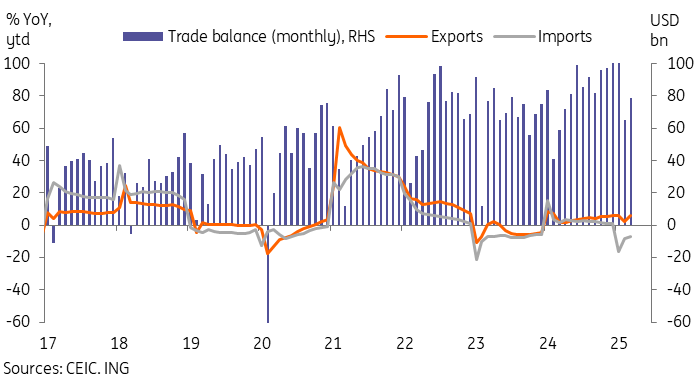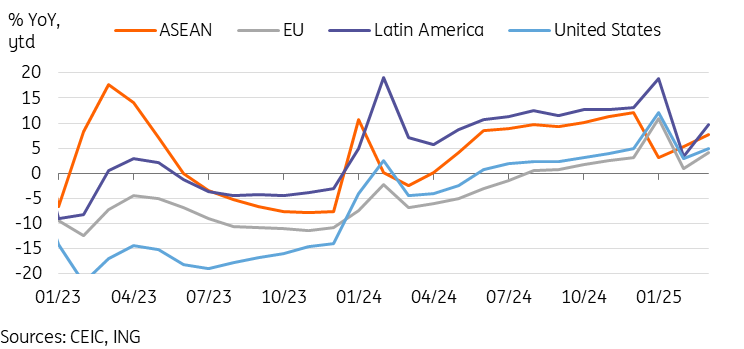President Trump’s fentanyl rounds of tariffs did little to dent China's exports in March, with growth beating forecasts once again. However, several categories already are starting to show the trade-war impacts. Next month's bilateral trade data is likely to fall off sharply.
China's first quarter trade balance beats expectations on stronger exports and weaker imports

Exports continued to beat expectations in March
Chinese exports bounced back stronger than expected in March, up 12.4% year on year from 2.3% YoY in the first two months of the year. Though trade data forecasts often have a high margin of error, exports were significantly higher than forecasts for 4.6% YoY growth. In the first quarter, exports grew by 5.8% YoY, just 0.1pp short from last year's annual growth rate.
By export destination, exports to the US picked up despite President Trump’s fentanyl tariff hikes of 20%. The March data brings the first quarter growth rate to 4.5% YoY, up from 2.3% YoY in the first two months of the year. Savvy US importers likely saw tariff hikes coming in April onward and frontloaded imports. Furthermore, the tariff exemption for packages already in transit may have also supported the data. The US aside, exports to many other regions accelerated in March. Exports to ASEAN, China's largest export destination, accelerated to 8.1% YoY in first quarter, driven by strong export growth to Vietnam, Thailand, and Indonesia. Other outperformers included exports to India (13.8%) and Latin America (9.6%). On the other hand, exports to the EU (3.7%), Japan (2.8%), and Korea (-1.7%) underperformed the headline growth.
By product, semiconductor (10.8%), household appliance (8.7%), and LCD display (8.4%) exports outperformed in the first quarter. However, we saw exports of footwear (-11.2%) and apparel (-1.9% contract, perhaps reflecting early impacts from tariffs where products with easy substitutions were displaced. Exports of rare earths also slumped -10.9% YoY, year to date, as export controls increased.
This month's data was highly anticipated, with markets looking for the first signs on how tariff might be starting to impact trade. The data showed that overall exports remained quite resilient, but that easily replaceable and price-sensitive categories are already taking a hit.
With a staggering 145% tariffs coming into effect, it's likely that next month's data will tell a dramatically different story.
Exports to US still in positive growth in 1Q25

Import weakness shows there's work to be done in shoring up domestic demand
Imports on the other hand fell to just -4.3% YoY in March, bringing the first quarter import growth to -7.0% YoY.
By product, the rise of the domestic car industry combined with a more cost-conscious Chinese consumer resulted in a sharp -44.5% YoY decline of auto imports in the first quarter. Continued sluggishness in the property market also resulted in related declines of steel (-10.5%) and lumber (-9.7%) imports. Energy and agricultural imports were both on the soft side as well.
The lone bright spots included hi-tech (9.2%), automatic data processing equipment (85.0%), and aircraft (156.7%) imports, which could've also reflected some pre-tariff import frontloading.
Strong trade surplus to support 1Q25 growth
As a result of outperforming exports and underperforming imports, China's trade balance rose to $273bn in the first quarter. This was nearly $100bn higher than the trade surplus from first quarter of 2024, and suggests that net exports will offer a nice boost to the first quarter 2025 GDP growth.
We're expecting first quarter GDP growth could hit 5.3% YoY, which will likely be the strongest reading of the year, barring a sharp U-turn in terms of external conditions and stronger-than-expected domestic stimulus.
April's sharp tariff hikes will likely have a dramatic impact on the next few months of data
While March data showed encouraging signs that the 20% tariff hasn’t significantly hampered China's exports. But the sharp escalation of tariffs since then no doubt will paint a much different picture once April's data comes in.
Trump's temporary carve-out of semiconductors, computers, and smartphones from the country-wide tariffs will offer some relief for those exporters. Indeed, we could end up seeing continued frontloading of imports to offset later tariff hikes that Trump has already signalled.
However, the rest of China's exports to the US (as well as US imports to China) will now be put to test a real-world case study for price elasticities. At the current tariff rates, it’s likely that trade in the majority of products which have a viable substitute on the global market will be discontinued. It's also likely that even products without viable alternatives could see trade temporarily plummet as importers wait to see if there will be any adjustment to tariffs -- and work through inventories -- before deciding to import new stock. As a result, it's likely that direct trade between the US and China will crater starting in April. It could take several months before we get any definitive answers on which party ends up bearing more pain from a sharp drop in trade. By that point, it’s possible that tariff scenario looks completely different from today.
As we’ve written in the past week, it's likely that China and the US are now in a test of endurance. Nonetheless, we expect that talks eventually will resume in the coming weeks and months. Much has been made of US de-risking of China in the past few years. But China's de-risking from the US, with a lower proportion of US-bound exports and fewer companies existentially reliant on US suppliers or customers, also has emboldened policymakers to retaliate.
China's US de-risking has emboldened policymakers to retaliate

Read the original analysis: China’s March exports shrugged off early tariffs, but headwinds are intensifying
Content disclaimer: This publication has been prepared by ING solely for information purposes irrespective of a particular user's means, financial situation or investment objectives. The information does not constitute investment recommendation, and nor is it investment, legal or tax advice or an offer or solicitation to purchase or sell any financial instrument. Read more here: https://think.ing.com/content-disclaimer/
Recommended Content
Editors’ Picks

EUR/USD bounces off lows, retests 1.1370
Following an early drop to the vicinity of 1.1310, EUR/USD now manages to regain pace and retargets the 1.1370-1.1380 band on the back of a tepid knee-jerk in the US Dollar, always amid growing optimism over a potential de-escalation in the US-China trade war.

GBP/USD trades slightly on the defensive in the low-1.3300s
GBP/USD remains under a mild selling pressure just above 1.3300 on Friday, despite firmer-than-expected UK Retail Sales. The pair is weighed down by a renewed buying interest in the Greenback, bolstered by fresh headlines suggesting a softening in the rhetoric surrounding the US-China trade conflict.

Gold remains offered below $3,300
Gold reversed Thursday’s rebound and slipped toward the $3,260 area per troy ounce at the end of the week in response to further improvement in the market sentiment, which was in turn underpinned by hopes of positive developments around the US-China trade crisis.

Ethereum: Accumulation addresses grab 1.11 million ETH as bullish momentum rises
Ethereum saw a 1% decline on Friday as sellers dominated exchange activity in the past 24 hours. Despite the recent selling, increased inflows into accumulation addresses and declining net taker volume show a gradual return of bullish momentum.

Week ahead: US GDP, inflation and jobs in focus amid tariff mess – BoJ meets
Barrage of US data to shed light on US economy as tariff war heats up. GDP, PCE inflation and nonfarm payrolls reports to headline the week. Bank of Japan to hold rates but may downgrade growth outlook. Eurozone and Australian CPI also on the agenda, Canadians go to the polls.

The Best brokers to trade EUR/USD
SPONSORED Discover the top brokers for trading EUR/USD in 2025. Our list features brokers with competitive spreads, fast execution, and powerful platforms. Whether you're a beginner or an expert, find the right partner to navigate the dynamic Forex market.